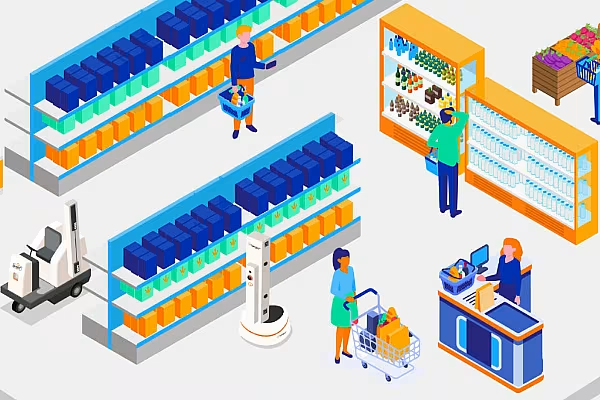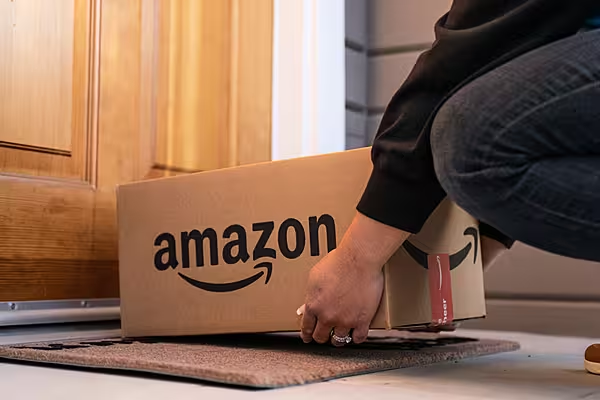Since its foundation in 2009, Brain Corp has been on a mission to support retail outlets and other busy public spaces, such as airports, hospitals and universities, with autonomous solutions that enable businesses to be more efficient.
In a retail context, the business works with Kroger, Walmart and Czech retailer Albert, among others, supplying autonomous floor-scrubbers and inventory management solutions, which free up time for personnel to focus on more important tasks, such as enhancing the customer experience.
The San Diego-based group has deployed some 30,000 autonomous machines globally, of which 70% have been introduced to retail. According to the company, some 25 billion square feet of retail space – equivalent to double the total retail floor space of the entire United States – was covered by its autonomous robots in 2023.
Embracing Automation
According to Michel Spruijt, Brain Corp’s chief revenue officer, while automation solutions have increasingly been deployed in warehousing and logistics in recent years, it took until the COVID-19 pandemic for their use to fully take hold in the retail environment, driven by labour shortages, cost increases, and the need to streamline operations.
“More and more retailers are willing to talk to us and see what automation can do for them, whereas, in the past, the immediate response was, ‘There’s nothing here for us,’” Spruijt explains. “Now we’ve seen a shift.
“You can do two things when it comes to automation: one, you can hide away from it until it catches up with you – and then you’re probably too late – or you can embrace the technology and see what it can do for you today and in the future.”
The best approach, he argues, is for retailers to trial solutions in one or two stores, and then build up gradually, as the benefits of automation are realised.
“Automation can free up people to handle customer interactions, ensure a smooth purchasing process, maintain well-filled shelves, and minimise checkout lines. More and more retailers are discovering that this is the way forward.”
Additional Insights
An example of a retailer that is maximising the opportunity that automation presents is US-based Sam’s Club, where Brain Corp has equipped its fleet of robotic floor-scrubbers with ‘scan towers’ that enable inventory data to be collected in real time, autonomously, as the scrubber makes its way around the store.
The solution not only measures out-of-stocks and inventory errors, but also provides potential additional insights, including product localisation, planogram compliance, product stock levels, and the verification of pricing accuracy.
“With the robots handling certain tasks, retailers can instruct their teams to manage other hands-on jobs, such as stocking, aisle clean-up, and loading trucks,” says Spruijt. “You can redirect people to perform different tasks than they would be doing if they were operating the floor-scrubber. Additionally, the machines generate a wealth of data, enabling optimisation of workflows and integration into data processes.
“In essence, this helps in multiple facets of the entire process, allowing teams to focus on the most crucial aspects on a day-to-day basis.”
Real-Time Implementation
Advancements in artificial intelligence and machine learning also mean that the data gathered can be put to use in real time.
“In terms of store-cleaning, retailers can easily track what has been cleaned, the timing of the cleaning, the quantity cleaned, and the frequency of cleaning,” says Spruijt. “It enables businesses to establish a proof of performance, for the benefit of the store and its customers.
“On the shelf-scanning side, meanwhile, instead of having people wandering the aisles looking to identify issues, you can allow AI and automation to examine the top priorities for action to optimise your efforts in the store. This approach enables you to channel more focus on tasks that can boost profits and overall performance.
"The emphasis is on providing the customer with the optimum experience, rather than attempting to do things halfway.”
Dynamic Retail Environment
As the physical retail space evolves, with ‘smart’ technologies permeating checkouts, refrigeration, lighting, and so forth, Spruijt believes that Brain Corp’s solutions are “an important piece of the puzzle”, enabling retailers to better optimise their store layouts and in-store traffic, which is responsive to the time of day or customer traffic.
“The retail experience can change, depending on various dynamics, such as the number of people in the store, stock levels, and other factors,” he says. “It’s about thinking in terms of a whole workflow.
“The one thing retailers don’t want is too much stock in the back room that’s just lying there, but it’s not just about having stock in the back room – you want to have the right products in the back room, so that you can replenish the products that are selling fast.
“The faster you can respond and the more optimum your process is to access the stock you need to refill, the better it is for both your customer and yourself.”
Finding A Balance
Recent years have seen an increase in the number of ‘fully automated’ stores opening in various parts of the world, and while Brain Corp’s core modus operandi is around automation, Spruijt believes that the traditional retail template isn’t going anywhere fast.
“Take a hotel, for example,” he says. “You will have people who are willing to pay a significant amount for a hotel where they have a fully electronic check-in. They check in quickly, they go to their room, and they might not encounter a single person. At the same time, there are people that want to be greeted personally at reception and reminded of what a ‘good customer’ they are. There will always be a difference, and retail is the same.
“I think, in time, we will see more and more automation, but, even if you look forward – ten, 15, or 20 years – there still will be a mix of both. There will be stores for the fast shopper, who needs to grab one or two things, and stores for those that want the personal experience, that want a broad range of fresh produce, all these kind of things.”
As to the immediate future? Spruijt sees opportunities for more automation in the self-checkout arena, in terms of driving greater reliability, as well as electronic price-labelling, which can be amended in real time, to mirror stock levels.
“I believe that the whole topic of ‘knowing your data’ and developing actionable insights on a daily basis will be a big thing in 2024,” he says. “I also think that gathering better insights on what’s really happening at store level will, in the next year or two years, really drive automation.”
For more information, visit www.braincorp.com.














